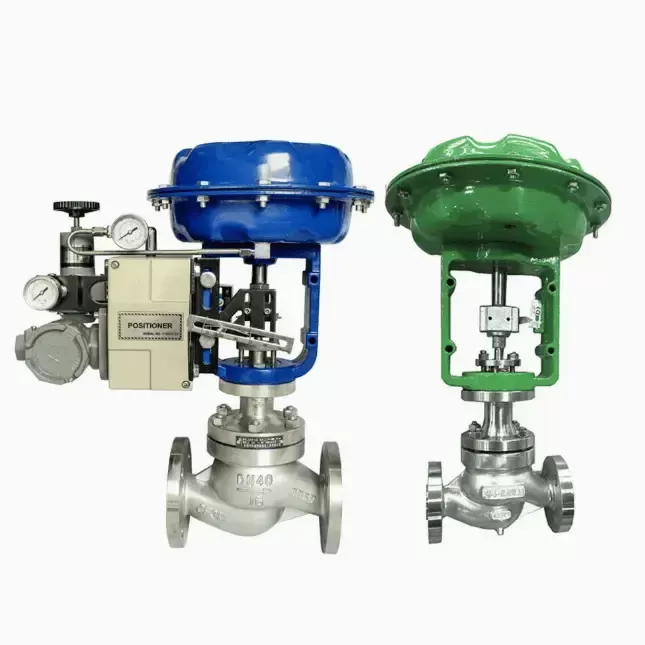Notifications

6 minutes, 43 seconds
-18 Views 0 Comments 0 Likes 0 Reviews

We are a top-tier control valve manufacturer in China, delivering superior valves and control actuators customized to meet diverse industrial requirements.
In today’s fast-paced industrial environment, precise control of process variables such as flow rate, pressure, and temperature is vital for ensuring product quality, operational efficiency, and system safety. Pneumatic globe control valves are key components that facilitate this control, engineered for reliability, responsiveness, and precision. They are indispensable across numerous sectors, including power generation, petrochemical production, water treatment, and pharmaceutical manufacturing.
A pneumatic globe control valve is a linear motion valve designed to regulate fluid flow via a globe-shaped valve body actuated pneumatically. Utilizing compressed air or gas to modulate valve position, these control valves enable automatic, real-time regulation of process parameters within complex industrial systems.
Remote Operation
Pneumatic globe control valves enable remote operation by responding to control signals from centralized systems. This capability enhances safety and accessibility, especially in hazardous or difficult-to-access locations.
Support for Automation Systems
These valves integrate seamlessly with distributed control systems (DCS) and programmable logic controllers (PLC), forming a critical part of automated control loops. They receive and respond to feedback signals, optimizing performance with minimal manual intervention.
Fast and Accurate Response
Equipped with rapid actuation capabilities, pneumatic globe valves quickly adapt to changing process conditions—maintaining stability in dynamic environments where continuous adjustment of flow and pressure is required.
Compatibility with PID Control Loops
By modulating flow based on continuous feedback, pneumatic globe valves work effectively within proportional-integral-derivative (PID) control loops, minimizing process variability and enhancing product consistency.
Enhanced Safety Integration
Configured for fail-safe operation, these valves can default to fully open or fully closed positions in emergency shutdown scenarios, reducing risk during power loss or system failure.
Process Optimization
Industries requiring precise fluid control—such as chemical processing, food and beverage, and energy production—rely on pneumatic globe valves for optimizing efficiency, reducing energy consumption, and improving throughput.
Pneumatic globe control valves comprise three main components:
Valve Body: Features a globe-shaped housing with an internal seat, designed to regulate fluid flow by modulating the space between the seat and plug.
Plug/Disc: A movable element that controls flow volume by adjusting its position relative to the seat.
Pneumatic Actuator: Converts compressed air pressure into mechanical motion to position the plug precisely.
Valve opening is governed by the air pressure applied to the actuator, typically controlled by an electro-pneumatic positioner that converts electrical control signals into accurate mechanical positioning.
Pneumatic globe control valves are widely used in industries requiring reliable, precise control:
Chemical and Petrochemical Plants: Managing hazardous or aggressive fluids with high accuracy.
Power Generation: Controlling steam and feedwater in boilers and turbines.
Oil and Gas: Flow regulation and pressure control in upstream and downstream operations.
Pharmaceutical Manufacturing: Sterile processing with stringent control requirements.
HVAC Systems: Regulating air and fluid flow for heating and cooling.
Food and Beverage: Ensuring sanitary conditions and precise temperature regulation.
Regular visual inspections detect early signs of leakage, corrosion, or wear. Key checks include:
Valve body and stem condition.
Actuator function and air pressure stability.
Valve response times and smoothness of operation.
Advanced condition monitoring tools can provide predictive maintenance insights.
Periodic cleaning prevents clogging and wear:
Remove sludge, scale, and deposits from valve internals.
Keep air supply lines free of contaminants for actuator reliability.
Proper lubrication reduces friction and wear:
Use manufacturer-recommended lubricants on stems and linkages.
Perform lubrication during scheduled maintenance to avoid process contamination.
Seals degrade over time due to thermal, chemical, or mechanical stress:
Inspect seals for cracking or deformation.
Replace seals promptly with compatible materials to ensure leak-tight performance.
Actuators must respond precisely to control signals:
Calibrate periodically to align valve position with input signals.
Inspect air supply components and mechanical linkages for wear.
Utilize digital positioners with self-diagnostics for enhanced monitoring.
Positioners ensure actuator accuracy:
Verify correct alignment and signal translation.
Update firmware and recalibrate as necessary to maintain compatibility with control systems.
Maintaining pneumatic globe control valves yields:
Reduced Downtime: Minimizes unexpected outages.
Improved Accuracy: Ensures precise process control.
Energy Efficiency: Reduces leaks and optimizes flow.
Enhanced Safety: Prevents catastrophic failures.
Regulatory Compliance: Supports safety and environmental standards.
Pneumatic globe control valves are critical to modern industrial automation, offering high accuracy, rapid response, and integration with advanced control systems. Regular, structured maintenance is essential to sustain performance, enhance reliability, and extend service life.
As industrial processes evolve towards smarter, digitally integrated manufacturing, the role of pneumatic globe control valves will continue to expand—making them not only vital components but strategic assets in achieving operational excellence.Know more about Google SEO Directory

